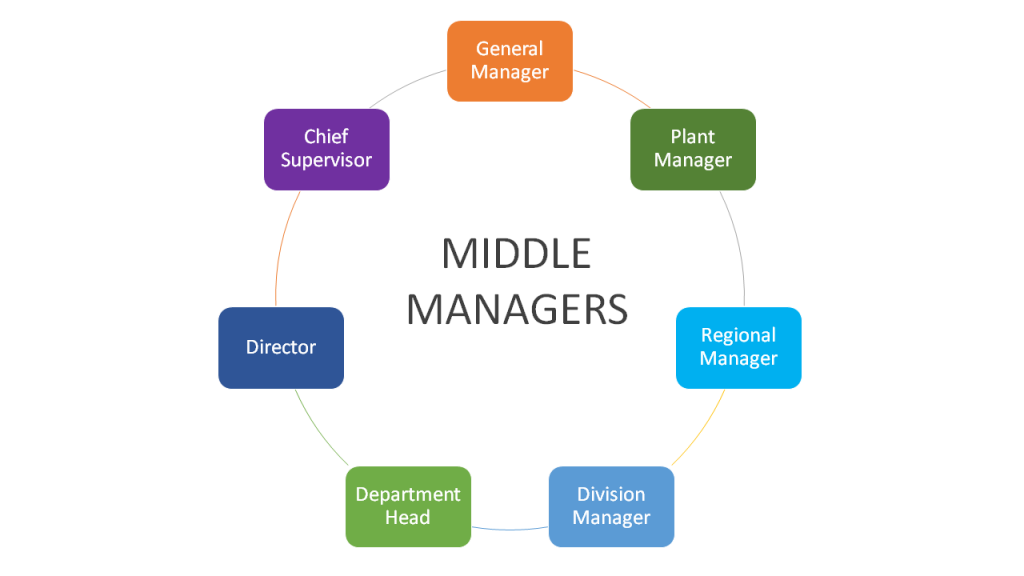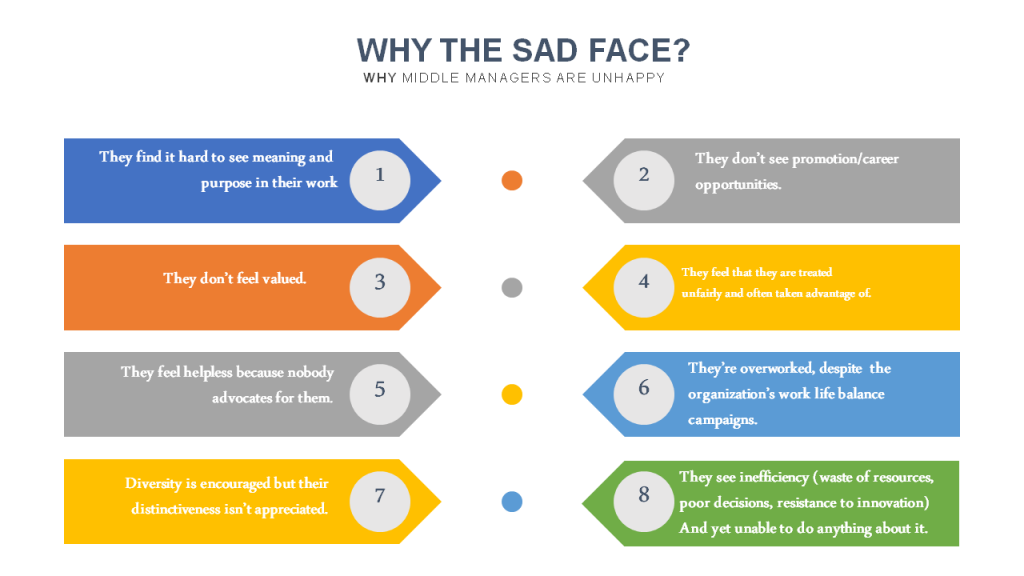What comes to mind when you think of the term “middle manager”?
Is it a cranky, bespectacled guy barking orders behind a desk? Someone who holds little power but spends a lot of time micromanaging people? Or someone whose career is in the doldrums?
I can’t blame you. Even sitcoms and pop culture memes portray the middle manager as a mockery by the employees who are often bullied by their higher-ups.
But before we pull the punch lines, I invite you to give your middle manager a second look. There’s more to them than meets the eye.
Middle Manager
A middle manager is the link between senior management and the junior levels of the organization. Unlike senior management, they are involved with the daily grind of running a business. They possess valuable information and are a repository of suggestions from the organization. Furthermore, the middle manager is a channel of communication. They are tasked to disseminate information (such as major decisions of executives) to the lower levels, and coordinate work between upper management and workers.
A middle manager is, well… a bit of a unicorn.
And Kathi, a division manager at a logistics firm, couldn’t agree more. The role feels mythical and unreal. She makes dozens of decisions each day. When she isn’t busy doing that, she’s saddled with managing and coaching subordinates (around 14 of them), and then reports performances to higher-ups (whose policies she enforces, even if she didn’t have a say in making those policies in the first place). In addition, she attends to daily operations, monitors each subordinate’s performance, and makes sure that everything is done in compliance with the law and what the organization needs. It’s simple on paper, but a nightmare in practice. Kathi feels she has it rough.
And she does. She has to take full responsibility for decisions made under pressure. And yet nobody can advocate for her when she needs it the most. It can be a thankless job.
This feeling of thanklessness is common in top-down, command and control organizations. In a collaborative work culture and leadership team, collaboration in the workplace involves individuals working together to solve problems across departments, management levels, and functions. This requires a different leadership mindset and improved interpersonal and team process skills that also spark higher levels of employee engagement. It also takes much of the double bind (damned if you do and damned if you don’t) sting out of middle management roles.
What does the research show?
In 2015 research by Columbia University — a survey of 22,000 full-time workers — revealed that 18% of supervisors and managers reported depression symptoms. (For owners and executives, it was 11%, 12% for blue-collar workers.) A separate study in 2014 found that job satisfaction for managers was in the bottom 5%.
Could these subjects be middle managers with low-performance ratings, insufficient training, or inadequate experience? It’s a valid first impression. However, many are college degree holders with at least 5 to 10 years of tenure. Most received a good (if not superior) performance rating in the last year too.
Why the dissatisfaction?
“If you want to look for the unhappiest people in an organization, head to a middle manager’s desk.”
A Harvard Business Review article summed it up:
Middle managers are often looked upon as mediocre, ineffective supervisors who couldn’t snatch promotions. But many don’t realize how they are the gearwheels that make things work. They aren’t rewarded for disasters averted, but are severely reprimanded when things go wrong – hence the double bind that results in anger and depression from a human psychology perspective.
Worse, many organizations don’t see the need for middle management. But now more than ever, as hybrid and remote work take over, middle managers are being called to the forefront to mediate and find common ground for all stakeholders. This means they are expected to deploy levels of communication flow and project focus that many have not been adequately trained to do, which lies at the feet of the C-Suite, CEO and Business Owners.
The challenge is real.
Middle managers are required to be both proactive leaders and engaged followers – AT THE SAME TIME. They also need to BROKER between people or groups who have conflicting agendas. While all these are happening, the connecting leader is expected to be a CHANNEL who amplifies voices (up and down the totem pole). Lastly, they have to tread a tightrope as they balance and appraise the demands from upper and lower levels.
Imagine having to plan for a redundancy scheme. Deciding who goes and stays while keeping the team motivated is no easy task. For example, implementing a digital platform that requires sales agents to log in sales conversations (micromanagement on the sales agent’s part, but quality control on the part of management).
Your middle managers are crucial and the following solutions apply
One of the bigger influences middle managers have is the ability to affect attrition rates and overall efficiency. Managerial support is far more crucial than C-level or upper management support when it comes to employee well-being. This is because they are in touch with the team. When they fall short, there’s a chain reaction with heavy costs in your balance sheet. Yes, it is measurable.
So don’t treat them like forgotten middle children. Don’t leave them out of training. Many organizations invest heavily in senior management enhancements and new manager training but forget to develop the middle managers. Mitigate burnout by balancing their workload and checking on them weekly for resources needed. Last but not least, give them a safe place to share their concerns. As they are tasked to give their subordinates one-on-one, give them their own safe forum as well.
The pandemic has changed the dynamics of the workplace. But the importance of collaboration between and among members of an organization remains the same. Now more than ever, team leadership must zero in on the outcome. Empower your middle managers with collaborative leadership training.
Get started HERE.
Copyright TIGERS Success Series, Inc. by Dianne Crampton
About TIGERS Success Series, Inc.
TIGERS Success Series of Bend, OR takes the guesswork out of collaborative workforce development. TIGERS provides a single proven system to grow talent, improve collaborative behavior and increase revenue.
TIGERS is introducing an International Certification program for existing consultants, leadership coaches, and independent project managers. It is TIGERS mission to improve the world of work for millions of employees and their leaders and is doing so by licensing accomplished consultants whose work improves the lives of the employees, leaders, and the community groups consultants serve.


